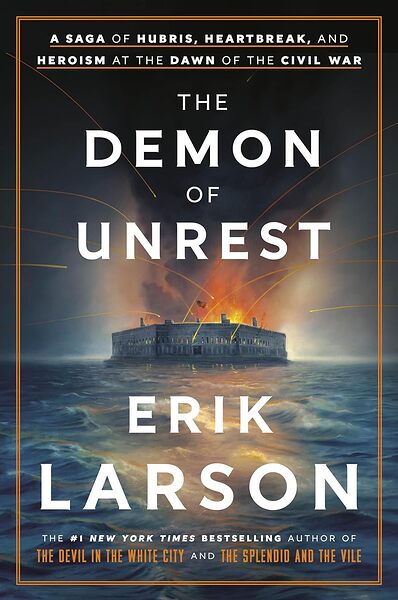Looking for a good read? Here is a recommendation. I have an unusual approach to reviewing books. I review books I feel merit a review. Each review is an opportunity to recommend a book. If I do not think a book is worth reading, I find another book to review. You do not have to agree with everything every author has written (I do not), but the fiction I review is entertaining (and often thought-provoking) and the non-fiction contain ideas worth reading.
Book Review
Fort Sumter Pictured As A Duel
Reviewed by Mark Lardas
June 16, 2024
“The Demon of Unrest: A Saga of Hubris, Heartbreak, and Heroism at the Dawn of the Civil War,” by Erik Larson, Crown, April, 2024, 592 pages, $35.00 (Hardcover), Large Print Paperback ($37.00), $14.99 (E-book), $24.75 (Audiobook)
Many books have been written about Fort Sumter, the opening battle of the American Civil War. Most do an adequate job of describing what happened. Some are outstanding. Few explain why events unrolled as they did. They present the big issues of why, such as slavery. Almost none get inside the heads of the participants of both sides to explain what motivated their actions.
“The Demon of Unrest: A Saga of Hubris, Heartbreak, and Heroism at the Dawn of the Civil War,” by Erik Larson, does just that. It explains what led both sides to behave as they did, and why the eventual outcome was virtually inevitable.
Larson examines the period from November 6th 1860, Election Day when Abraham Lincoln was voted President, to April 1861, and the surrender of Fort Sumter with its immediate aftermath. He takes occasional excursions into the past to provide context, and provides a couple of chapters at the end to tie things up.
He frames the book using John Lyde Wilson’s 1858 book “The Code of Honor” or “Code Duelo.” Every chapter in “The Demon of Unrest” opens with a quote from the book, describing different stages in arranging a duel. It underscores how the Southern concept of honor – and the North’s lack of understanding of it – fueled the events leading up to secession and ultimately war.
Alternating between North and South, he explores both cultures. The South is revealed as an honor-driven society, touchy and sensitive to insult. Chivalry is its hallmark; a land where knights and peasants exist in the minds of its leaders. The North is shown as a place preferring what it views as the modern. Egalitarianism is its ideal, the concept where every man stands on his merits rather than his birth. Larson shows how those beliefs drove the actions of both sides’ leaders.
“The Demon of Unrest” shows the danger of failing to understand those with whom you disagree. (Something Larson proves guilty of in his best-ignored prologue.) Had both sides a better understanding of the other the Civil War might have been averted or mitigated. Larson shows why this was highly unlikely for the insular South. He also shows the North guilty of similar failings, projecting their own values on their Southern counterparts.
“The Demon of Unrest” is excellently written, entertaining and enlightening. Its applicability to today’s political scene may be the best reason to read it.
Mark Lardas, an engineer, freelance writer, historian, and model-maker, lives in League City. His website is marklardas.com.
